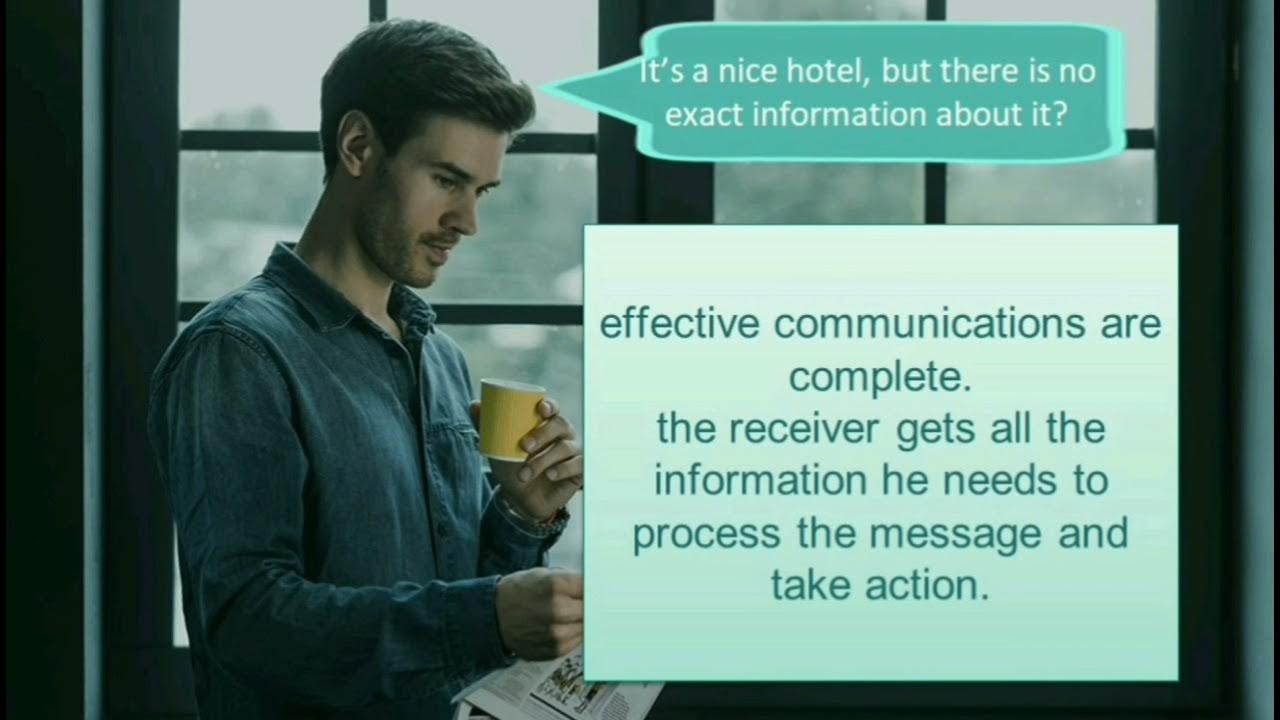The Seven (7) Cs of Effective Communication
Summary
TLDRThe transcript outlines the seven C's of effective communication: clarity, correctness, completeness, concreteness, conciseness, consideration, and courtesy. It emphasizes using simple language, avoiding jargon, and ensuring factual accuracy. The message should be complete, supported by facts, and delivered with brevity to save time and highlight key points. It also stresses the importance of considering the audience's emotions and cultural background, and maintaining respect and honesty throughout the communication process.
Takeaways
- 📝 Use clear and simple sentences to avoid confusion and ensure the message is easily understood.
- 🚫 Avoid jargon and technical terms that may not be familiar to all listeners; if necessary, provide clarification.
- 🔍 Ensure the correctness of the facts in your message by double-checking from reliable sources to avoid spreading misinformation.
- 📑 Proofread your message to check for errors before sharing it with the public.
- 📈 Deliver complete and accurate information so that the audience knows exactly what is expected of them.
- 🗣️ Support your message with concrete facts and opinions from reliable sources to build confidence in your communication.
- 🔪 Be concise by using as few words as necessary, eliminating unnecessary sentences and filler words.
- 💡 Highlight the most important details of your message to make it cost-efficient and time-saving.
- 🌐 Consider the emotions, education, cultural background, and mindset of your audience to tailor your message appropriately.
- 🌟 Show optimism by focusing on possibilities rather than limitations when communicating with your audience.
- 🤝 Always maintain respect and honesty in your communication, being cautious to avoid prejudice and biases.
Q & A
What are the seven C's of effective communication?
-The seven C's of effective communication are Clear, Correct, Complete, Concrete, Concise, Considered, and Courteous.
Why is it important to use short and simple sentences when communicating a message?
-Using short and simple sentences helps to avoid confusion and ensures that the message is easily understood by the audience.
What should be done if jargon or specialized terms are necessary in a message?
-If jargon or specialized terms are necessary, they should be accompanied by explanations or clarifications to ensure the audience can understand them.
How can one ensure that the information in a message is accurate and not misleading?
-One should double-check the facts against reliable resources and proofread the message to avoid sharing misinformation or fake news.
What does it mean for a message to be complete?
-A complete message provides all the necessary information so that the audience knows what must be done, avoiding uncertainty and incorrect responses.
Why is it important for a message to be concrete?
-A concrete message is clear, supported by facts, and based on reliable sources, which allows the speaker to be confident and credible.
How can one be concise in delivering a message?
-Being concise involves using as few words as possible, avoiding unnecessary sentences and filler words, and focusing on the most important details.
What is the significance of considering the audience's emotions, education, and cultural background when communicating?
-Considering the audience's background helps tailor the message to their understanding and emotions, making it more relatable and effective.
How can one show optimism towards the audience in a message?
-Showing optimism involves emphasizing what is possible rather than focusing on limitations, which can inspire and motivate the audience.
Why is it essential to be respectful and honest when communicating?
-Being respectful and honest builds trust and credibility, and it is particularly important to avoid prejudice and biases when interacting with others.
Are there any additional factors to consider when delivering a message besides the seven C's?
-While the seven C's provide general rules for effective communication, there are many other factors to consider, such as the context, the medium of communication, and the audience's needs and preferences.
Outlines

Этот раздел доступен только подписчикам платных тарифов. Пожалуйста, перейдите на платный тариф для доступа.
Перейти на платный тарифMindmap

Этот раздел доступен только подписчикам платных тарифов. Пожалуйста, перейдите на платный тариф для доступа.
Перейти на платный тарифKeywords

Этот раздел доступен только подписчикам платных тарифов. Пожалуйста, перейдите на платный тариф для доступа.
Перейти на платный тарифHighlights

Этот раздел доступен только подписчикам платных тарифов. Пожалуйста, перейдите на платный тариф для доступа.
Перейти на платный тарифTranscripts

Этот раздел доступен только подписчикам платных тарифов. Пожалуйста, перейдите на платный тариф для доступа.
Перейти на платный тарифПосмотреть больше похожих видео

7 Cs of Effective Communication

Basic Principles of Communication (7 C's)

7Cs of an Effective Communication (Oral Communication MELC 1 Day 2)

Lesson 3 (Part 1): Functions and Features of Effective Communication | Oral Communication in Context

Tips to Improve Verbal and Written Communication Skills | Beyond Tech

7 Principles of Effective Communication & Intercultural Communication
5.0 / 5 (0 votes)
